What to know about driving in Iceland
Driving in Iceland is the most rewarding and relaxing way to see the country. But with changeable weather, free-roaming livestock, and often unpaved roads, it may be a little different to driving in your home country. In this Icelandic driving guide, discover what you need to know before you set off.

Do I need a car in Iceland?
If you want to explore Iceland to the fullest, your best option is to hire a car. It gives you the freedom to travel at your own pace and to seek out the unique experiences that will make your trip unforgettable.
The alternative is that you rely on public transport and tour buses. These can be a great way for you to meet like-minded travellers, for instance, but they can also be quite restrictive. You need to follow pre-planned tour itineraries and schedules, which can mean that you see Iceland’s stunning sights with large crowds. And most of the tours run from Reykjavík, making it a little difficult to travel to the wilder parts of the country.
By renting a car, you can manage your own time, focus on the specific destinations you want to see, and get off the beaten track. Plus, you have a comfortable space that’s all your own for as long as you stay in the country.
So, booking a rental car in Iceland is a must. But make sure to do it well in advance. During the busier summer months, there’s a lot of demand for vehicles. And you won’t want to miss out!
Icelandic road systems and road conditions
In Iceland, there are 3 main types of roads. They are important to know, as some vehicles aren’t allowed on some roads.
Paved roads
These are standard roads you’ll be familiar with from your home country. Often known as “primary” roads in Iceland, they’re the tarmacked routes that connect the major towns and villages. As most of those settlements are around the coast, that’s where you’ll find most of the paved roads.
The most famous road in Iceland—the Highway 1 or “Ring Road”—is a paved road that travels in a loop around the whole of the country. It’s where you’ll be spending most of your time when you drive in Iceland.
The speed limit on paved roads is 90 km/hour in rural areas, or 30-50 km/hour in populated areas. These roads are very well-maintained and they will stay open all year round.
Gravel roads
The second most common type of roads are gravel roads, or “secondary” roads. As the name suggests, they’re unpaved and covered in gravel. They typically connect the paved roads to the smaller settlements and farms across Iceland.
You can drive any rental vehicle on gravel roads in Iceland. They are only found in lowland and coastal areas, meaning that they are usually open throughout the year. The speed limit is 80 km/hour.
Something to look out for is where gravel roads connect to paved roads. It’s important to slow right down when the surface changes, to make sure you don’t lose control of your vehicle.
F roads
Icelandic F roads, or Highland roads, are the routes that travel through the Highlands. These connect some of the most remote areas of the country, and some of them are very wild indeed.
You will need a 4x4 to drive on F roads. Typically, when you hire a car in Iceland, you’ll be asked whether you’re intending to drive on these roads. It’s forbidden to drive in a standard 2-wheel drive road vehicle on these roads, and you’ll be fined if you do so.
What’s essential to know is that F roads are not open all year. As they travel through high, remote areas, they’re often covered in snow in colder months—and they won’t usually be cleared throughout the season. So, if you’re driving in Iceland in winter, stick to the paved and secondary roads.
Weather in Iceland
In any season, the weather in Iceland is very changeable. We can receive a lot of rain—and snow during the winter—as well as periods of beautiful sunshine. When you’re driving around Iceland, it’s important that you’re prepared for any weather. Here’s what to expect in all seasons.
- Winter. The winter in Iceland brings snow and ice, particularly in the rural mountainous areas. In the south, you can expect average temperatures around freezing, while in the north averages are usually lower. Most F roads will be closed.
- Spring. As winter recedes, temperatures rise and there are typically fewer storms. Late spring is the driest period of the year in Iceland, but you should still expect some rain. That can fall as snow in Highland areas, meaning F roads are often still closed.
- Summer. Driving in Iceland in summer is the easiest time of year. It’s typically drier, the snow has melted from the roads, and the Highland F roads are open.
- Autumn. One of the most changeable seasons in Iceland, autumn can bring summer road conditions or wintry storms. Check if any F roads are open before travelling.
Weather seriously affects Iceland’s road conditions. But what makes driving in Iceland a little more challenging than in other countries is that you can experience a variety of weather at any time of the year. What you should look out for in particular is thick fog, snow, and high winds, which can pose additional challenges.
If you’re planning to drive in winter, you should ensure that your vehicle has adequate tyres. At Höldur, we ensure that every vehicle is equipped with the right tyres for your journey—whether winter tyres or studded tyres.
Wherever you’re planning to drive, check the conditions before you set off. The Europcar app will be your most useful guide. Otherwise, the Icelandic Met Office is a handy tool for regional weather forecasts and you can also find webcams and up-to-date information on road and weather conditions on road.is.
Another important challenge in Iceland is the light. In the shortest days of winter, Iceland receives as few as 4 hours of daylight. We don’t recommend that you drive in the dark at all. But you should also watch for low sun, in any season. It can be dazzling, particularly when the roads are wet—so, bring some sunglasses with you.


Essential safe driving tips in Iceland
To stay safe on the roads in Iceland, follow these driving tips and Icelandic traffic rules:
- Know your roads. Different types of roads—paved roads, gravel roads, or F roads—have their own rules, speed limits, and challenges. Most importantly, you won’t be able to drive on F roads in the winter and during summer you´ll need a 4x4 Suv to drive on F roads.
- Check the weather conditions before you travel. Weather can change quickly in Iceland and that means road conditions are changeable too. Check websites such as the Icelandic Met Office and road.is before you travel so that you’re prepared.
- Drive on the right. In Iceland, we drive on the right and overtake on the left. The steering wheel is on the left in every vehicle.
- Pull over to take photos. Iceland is beautiful, but stopping in the middle of the road to take photos can be dangerous. Always pull off the main carriageway if you want to stop.
- Obey the speed limit. On paved roads, the speed limit is 90 km/hour. On gravel roads, it’s 80 km/hour. In urban or developed areas, the limit can be between 30 and 50 km/hour. That’s a limit, not a target. On gravel roads in particular, you’ll often need to slow down considerably to safely pass other road users.
- Be aware of road bridges. Many bridges in Iceland only have a single lane. The etiquette is that whoever arrives first can cross first. However, if there’s an oncoming vehicle, it’s always safer to slow down and assess the situation before crossing.
- Check before crossing rivers and streams. Driving into the highlands is only allowed on four-wheel-drive SUV car groups that Holdur car rental allows for such use. In Highland areas, roads often cross flowing water. But these streams change depth and speed very frequently. Before you cross in a vehicle, check the flow. If you wouldn’t cross on foot, don’t cross in a car. Keep in mind that no insurance covers damages caused by driving in or across rivers or any kind of waterways.
- Watch out for livestock. In Iceland, livestock—including sheep and reindeer—roam freely. It’s not uncommon for them to stand on or cross the road, particularly in the east of the country. Pass any animals slowly, so that you don’t startle them.
- Wear your seatbelt. As in most countries, it’s compulsory to wear your seatbelt in Iceland. It’s also the safe thing to do.
- Never drive off road. In Iceland, it’s forbidden to drive off the marked roads. That’s due to conservation rules. The fines can be very expensive, so it’s best avoided.
- Keep your lights on at all times. It’s the law to have your lights on whenever you drive—both during the day and night. In many Icelandic cars this will be automatic. But check that your lights are on before pulling off.
- Obey traffic signs. Icelandic traffic signs are much like signs in other countries. There are 2 that you should look out for in particular. “Lokað” means “closed”, and you should never try to drive on a road marked closed. “Malbik endar” means “paved road ends”, and it’s a signal for you to slow down before entering a gravel road.
- Avoid driving at night or on ice. There are 2 situations that visitors to Iceland struggle with most: driving in the dark and driving on ice. For your safety, it’s best to avoid them both.
- Mind your doors in strong winds. If it’s very windy, the wind can catch your door when you go to open it. This can cause damage to your door or fenders, so be very careful when getting in and out of the car in strong winds.
- Have the right tyres for your journey. If you’re driving in winter, you’ll need winter tyres or studded tyres. Luckily, from November 1st until April 15th all our cars come equipped with studded winter tires at no additional charge.
Renting a car in Iceland
The best way to see the country is to rent a car in Iceland. It gives you the freedom to travel wherever you like, all at your own pace.
At Höldur, we are the largest car rental operator in Iceland and the country’s Europcar franchisee. We have over 7,000 rental vehicles, as well as rental outlets and service stations in towns across the country.
Our most popular rental outlets are conveniently located at Keflavík International Airport and in central Reykjavík. They’re great places to pick up your vehicle before heading off on an Icelandic road trip.
We have a wide variety of vehicles available, including electric vehicles (EVs), 4x4s, and motorhomes. Most visitors to Iceland will be happy with a standard vehicle, as they won’t be venturing onto Iceland’s F roads. However, if you’re planning a trip to the Highlands on your Iceland adventure, you’ll need a 4x4 rental. It’s illegal to drive on F roads without one.
Iceland is also well-served by EV charging infrastructure (which you can find more about below).
What car insurance will I need?
All Höldur rentals come with basic insurance as standard. This includes:
- Collision damage waiver, which covers you against third-party loss. The policy has an excess of ISK 250000 ($1,800 USD) for passenger cars and/or ISK 450000 ($3,200 USD) for 4x4s, SUVs, and larger cars.
- Personal accident insurance, which provides protection for injuries suffered by you or your passengers. It’s a legal requirement in Icelandic law.
- Theft protection, which protects you against the theft of the vehicle. The basic policy doesn’t protect against theft of your personal belongings.
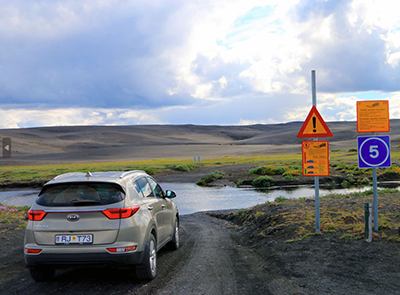
If you want additional protection, you can upgrade to medium or premium cover. With medium cover, you get super collision damage waiver, which significantly reduces your excess. You also get gravel protection, to cover your windscreen and glass against debris from unpaved roads. Premium cover reduces your excess to zero and includes protection against sand and ash damage.
No cover from Höldur or any other rental operator will cover damage to your vehicle’s chassis, gears, or drive caused by rough roads or by driving across water. That’s the driver’s responsibility. Similarly, we do not cover any damage to 2-wheel drives resulting from driving on F roads.
What documents do I need to rent a car in Iceland?
To hire a car with Höldur, you’ll need to have the following documents:
- Your driving licence. You don’t need to have an international driving permit. Instead, just bring your domestic licence. You’ll need to have had it for at least a year.
- Your passport or ID. This is required under Icelandic law.
- A credit card or a Europcar charge card. This needs to be valid for the period of rental.
Driving electric and hybrid vehicles in Iceland
If you’re an environmentally conscious traveller, you may be interested in renting an electric vehicle. In Iceland, they’re very common, making up over 40% of car sales. You can hire an EV with Höldur, but there are some things to know before you do so.
Firstly, as you may know, there are 3 main types of EVs, all of which are available through Höldur:
- Battery EVs (BEV), which are entirely electric. They don’t require any petrol or diesel, as they are fueled entirely when their battery is plugged into a domestic or public charging point.
- Plug-in hybrid EVs (PHEV), which have an electric motor as well as a diesel or petrol engine. You plug in the vehicle to charge the battery, which typically lasts for about 40 miles (64 km). Once the battery is depleted, the vehicle will switch to the standard petrol engine.
- Hybrid EV (HEV). Finally, a HEV can’t be charged with electricity. Rather, the petrol engine will charge the electric motor.

Overall, BEVs have the lowest environmental impact, as they do not have any emissions. However, if you’re planning to travel long distances, it can be reassuring to have both petrol and electric engines.
That’s because refuelling is an important consideration when driving an EV. Luckily, you will find hundreds of EV charging stations across Iceland, mainly around Highway 1, the “Ring Road”.
However, it’s important to be aware of the range of your vehicle and the type of charging technology it requires. For instance, if you’re driving a Tesla, you may need a specific charging point. However, with a Tesla, you’ll likely be able to drive 400 miles (620 km) before needing to recharge.
The charge range will depend on the vehicle. All hire vehicles will clearly show this information for your reference. It’s particularly important that you take note of this if you’re going to a remote area. You should always make sure you fill up so you have enough charge for your entire journey.
Another important thing to know is that you won’t be able to drive EVs in the Highlands. They’re not suitable for remote roads and should never be used to cross a river. Further, you won’t find any charging points in the Highland areas. If you intend to visit these areas on your Iceland self-drive trip, hire a 4x4.
At Höldur, we have a variety of vehicles to suit any trip—whether that’s a business trip to Reykjavík and the wider capital area, or a journey around the whole of Iceland.
Read more about driving electric and hybrid vehicles in Iceland.
Fueling and charging guide: Iceland’s EV charging stations and petrol pumps
While Iceland has a reputation for being very wild, you’ll easily find everything you need to fuel up on your road trip—no matter where you’re heading.
In Reykjavík and the wider Capital region, fueling and charging stations are typically open 24 hours a day. As this is where most of the people in Iceland live, it’s also where you’ll find most of the charging infrastructure.
Outside of this area, charging stations may have different opening hours. This is because many of them are privately operated and they can be located in quiet areas.
Most fuelling stations will have self-service pumps, which will accept debit and credit cards, as well as smartphone payments. These are often available even out of hours, when the station itself may be closed.
You will also find many EV charging stations across the country. Every EV we rent will include a map of Iceland’s charge points. Be aware that these charging stations come in a variety of technologies:
- Tesla Superchargers. There are 7 Tesla charging stations across Iceland, which are compatible only with Tesla vehicles.
- High-power charging. Many EVs can use high-power charging stations, also known as ultra-fast charging stations. These can charge a vehicle to almost full in about 30 minutes.
- Standard EV charging. If you’re charging your vehicle from a standard public or domestic charging point, it can take up to 8 hours before it’s fully charged.

Parking rules and payment methods in Iceland
As in any other country, parking regulations change depending on where you are in the country and the type of parking space. Sometimes it’s free to park, but often there will be a charge. Fortunately, every urban area or car park will be clearly signposted with the relevant rules.
Parking in urban areas
If you’re visiting cities and towns such as Reykjavík and Akureyri, you’ll need to be careful about where you leave your vehicle.
You should only park in designated parking areas, whether that’s a parking lot or an on-street parking spot. Unless a space is marked explicitly for public parking, please do not park there. It may be a residential space or you may be parking illegally.
It’s also important to be aware of parking zones. As in many other cities worldwide, parking in some areas is restricted to residents or business owners in that area. Speak to your hotel or accommodation to see if you have permission to park.
That said, on-street parking is usually easy, clearly signposted, and sometimes free. Check the specific space before you park. See also our comprehensive guide to parking in Reykjavík.
Parking in rural areas and at attractions
Most visitor attractions in Iceland have their own designated car parks. These are included on satnavs and navigation apps, and their parking regulations are usually very clearly signposted.
Most of them charge an hourly fee for you to park. These fees differ from location to location, so you’ll need to check locally for prices. Many car parks also have EV charging facilities, although often for an additional fee.
Wherever you visit in Iceland, please use the designated car parks. Local people often use the roads, and it affects everyone if you park alongside the carriageway to avoid car park fees. Find even more information in our article What You Need to Know Parking in Iceland.
Other parking tips for visitors
No one wants to receive a parking fine when on vacation. To avoid one, stick to the local regulations.
- Use the parking spaces when available. Particularly around visitor attractions, please don’t park on verges or roads.
- Only park campervans and motorhomes in designated areas. If you’re staying overnight in a campervan, you must park in a campsite—not in a layby or offroad.
- Choose how you want to pay for parking. You can usually pay for parking with an app, smartphone, or, less commonly, cash.

Tolls and tunnels in Iceland
While most roads in Iceland are public and free to use, there’s one road that charges a toll. This is the Vaðlaheiðargöng tunnel, next to Akureyri in North Iceland.
The tunnel is part of Highway 1, the “Ring Road” that travels around Iceland. It is 7.4 km (4.5 mi) long, and it functions as a detour between Akureyri and Húsavík. If you don’t want to pay, you don’t have to drive through the tunnel at all. Instead, you can take the 21 km (13 mi) route via the Víkurskarð pass.
Like all tolls, you have to pay to use the specific stretch of road that goes through this tunnel. For a single trip in a car or personal vehicle, the fee is ISK 1,500 ($11 USD).
You don’t have to pay before using the tunnel. However, payment needs to be made within 24 hours of your journey. You can pay online here, or via the Veggjald app. As a driver of a rental vehicle, it’s your responsibility to ensure that the payment is made. Find more useful and detailed information here Tolls and Tunnels in Iceland: A Driver’s Guide
Public transportation in Iceland
The best way to travel around Iceland is by rental car. However, there will be some moments—for instance, travelling from the airport or around Reykjavík—when it will be useful to travel by public transport.
Taking the bus from Keflavík airport
Unless you’re hiring a car at Keflavík International Airport, the best way to travel into Reykjavík is by bus. The most convenient option is the Flybus.
The Flybus is a bus that runs regularly throughout the day from Keflavík to the city centre. 17 buses run each day, but the service is scheduled based on the flights’ arrival times. So, if there’s any delay to your flight, the bus waits.
Travelling around Reykjavík by bus
There are two options for travelling around Reykjavík on public transport as a visitor. You can use the city’s public bus service, or take the Hop-On Hop-Off bus tour.
Reykjavík’s public bus service is run by Strætó BS. The company operates 27 routes in the capital and 18 routes outside of the city. These run from about 06:30 in the morning during the week to about midnight, depending on the route. At the weekend, they start a little later. You can use the Klappið app to discover journeys, plan your route, and pay for tickets.
Alternatively, the Hop-On Hop-Off buses are designed for visitors to the city. They follow a set route and you can jump aboard and get off as many times as you like throughout the day.
Frequently asked questions about driving in Iceland
What side of the road do Icelanders drive on?
When in Iceland, you should drive on the right and overtake on the left, as in much of the rest of Europe. Vehicles are left-hand drive, meaning the steering wheel is on the left side.
What are the driving conditions like in Iceland?
Road conditions in Iceland depend on the type of carriageway you’re driving on, as well as the weather.
There are 3 types of road in Iceland: paved roads, gravel roads, and F roads. Paved roads are tarmacked and much like roads you find anywhere else in the world, while gravel roads are unpaved. Both can become icy in the colder months.
F roads are roads that travel exclusively through the Highlands. These are unpaved, they may pass through rivers, and they’re typically completely closed during the winter.
The conditions of all of these roads are highly dependent on the weather. Iceland often experiences very low temperatures, high winds, and thick clouds that can seriously reduce visibility. You should check the forecast before travelling.
Where is the Rainbow Road in Iceland?
There are 2 streets in Iceland known for their rainbow colours.
One is Skólavörðustígur, in central Reykjavík, which runs from the Hallgrímskirkja church to the busy shopping street, Laugavegur. It was painted in these colours to celebrate Reykjavík Pride, in support of local LGBTQ+ people.
Another is in the village of Seyðisfjörður, a small town in the far east of Iceland. It famously leads up to the blue church in the centre of the village.
What is the minimum age to rent a car in Iceland?
In Iceland, you must be at least 20 years old to rent a car. From the age of 20, you can rent standard vehicles and vans. After the age of 25, you can also hire SUVs and premium vehicles.
Whatever your age, you need to have had your licence for at least a year before you can hire a car in Iceland.
Can you turn right on red in Iceland?
It’s illegal to turn right at a red light in Iceland, unless a sign explicitly says it's permitted. However, that’s not very common.
What is an F road in Iceland?
F roads are a particular class of unpaved roads in Iceland. These are roads that go through highland areas in Iceland.
As such, F roads have their own particular challenges. Firstly, they often cross rivers and streams that don’t have bridges, meaning you’ll need to ford them in your vehicle. Secondly, they’re often closed during the winter months, as they’re not cleared of snow throughout the season.
Passenger cars and 2wd vehicles are strictly forbidden to drive on F roads. Instead, we strongly encourage you to drive on F roads only if you have a 4x4.
What is the speed limit on Route 1 in Iceland?
Route 1, otherwise known as Highway 1 or the “Ring Road”, is a paved road that circles the entire island of Iceland. As a paved road, the speed limit is 90 km/hour in rural areas. If you pass through a populated area on Route 1, you may need to slow down to 50 km/hour.
Do I need an international driver’s licence to rent a car in Iceland?
You do not need to have an International Driving Permit to drive or rent a car in Iceland. Your normal licence from your home country is enough for you to hire a car. However, you normally need to be at least 20 years old and have had your driving licence for at least a year.
Do I need to rent a car at Keflavík Airport?
You do not need to rent a car at Keflavík. At Höldur, we have many rental outlets in towns and cities across the country. For instance, rather than at the airport, you can rent a car in Reykjavík.
Is it necessary to use headlights while driving in Iceland?
In Iceland, you are legally obliged to have your headlights on whenever you are driving. This rule applies during the day as well as during the night.
Many models of car will automatically turn on the headlights as you start the engine. However, you should always check that your lights are on before driving off.
Is it okay to drive off-road in Iceland?
It is never permitted to drive off-road in Iceland. This is to conserve the landscape and to ensure the safety of drivers. If you are caught driving off road, you will be fined.
How long is the drive from Reykjavík to Golden Circle?
The Golden Circle is one of the most popular itineraries in Iceland. It consists of 3 sights: Þingvellir National Park, Gullfoss waterfall, and the Geysir geothermal area.
Þingvellir is the closest attraction to Reykjavík. The journey from the city takes 45 minutes and is a distance of 45 km (28 mi).
The furthest attraction from Reykjavík is Gullfoss waterfall. The drive from Reykjavík takes 1 hour 45 minutes, covering a distance of 120 km (72 mi).
How long is the drive from Reykjavík to Blue Lagoon?
The Blue Lagoon is a short distance outside of Reykjavík. It is 50 km (31 mi) from the city centre, and the drive takes about 45 minutes.





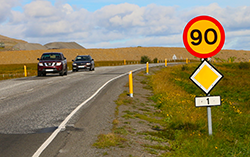
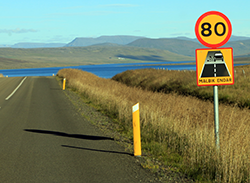






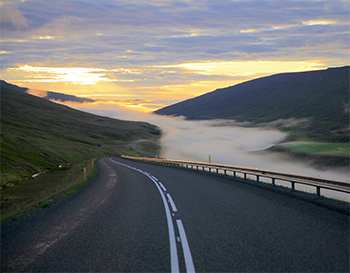
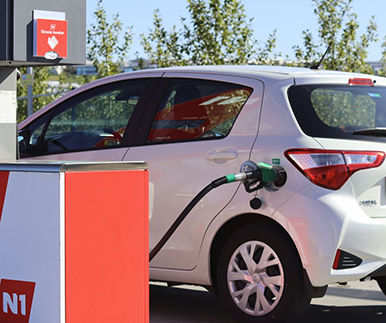

 - Bílaleiga Akureyrar
- Bílaleiga Akureyrar

